On revisiting art practices of the early post-independence years one learns of the painting traditions that Pakistan inherited and the cultural and political environment within which they evolved. Technically four approaches stand out because they were different from each other in attitude and temperament. These painting trajectories also defined the nature of the art legacies and the extent to which they were being utilised, modulated or rejected in favour of new trends. For senior artists, with established careers in pre-partition India, fidelity to tradition was important; those exposed to Western styles under the British Raj continued their pursuit of Victorian academic Naturalism while the younger painters opted for the novelty of 20th century modernism.
An ‘Oriental’ tradition of small paintings comprising layers of transparent washes first originated in Calcutta in the early 20th century. An adapted version of this New Bengal School style found favour with artists in Punjab but it was Abdur Rehman Chughtai’s unique take on this tradition — technically and conceptually — that infused the style with a singular brilliance. Acknowledged as the national artist of Pakistan, Chughtai was among the few — or the only one — to be recognised in India both before and after Partition with a considerable following abroad as well. His early figurative paintings, representative of undivided India of the ’20s, visualised Indo-Islamic history, Urdu and Persian poetry as well as Hindu gods and goddesses, Buddhist subjects and Indian cultural life.
After independence, illustration of Hindu/ Buddhist subjects and Ghalib’s poetry was set aside as Chughtai became immersed in giving visual definition to Allama Iqbal’s poetry and philosophical musings that had inspired the Pakistan movement. This corpus titled Aml-i-Chughtai was his magnum opus. He also painted Mughal royalty, Islamic heroes and characters from classic folk legends, genre scenes and college girls.
Four painting traditions define the nature of art legacies in Pakistan
Echoes of this reclaiming of heritage for the modern world that Chughtai spoke of years ago can be witnessed in the primacy the contemporary miniature enjoys today. Deconstruction and reinvention of the orthodox miniature might not have taken place if Haji Mohammed Shariff and Sheikh Shujaullah — the last of traditional miniature painters in Lahore at the time of Partition— had not persevered in preserving the orthodox mannerism. The two ustads had ancestral links to the profession and were the last of their breed in Pakistan. Both had enjoyed considerable respect and prosperity between 1935 and 1947 when British interest in miniatures was growing in Delhi. When their British patrons left, they survived by teaching and through occasional commissions.

Haji Shariff taught technique and philosophy of painting at the Mayo School of Arts — later renamed as the National College of Arts (NCA) — from 1945 to 1966. When he retired due to poor eyesight, Sheikh Shujaullah filled his place. His death in 1980 marked the end of the ustad-shahgird transmission of miniature painting. Soon after, his student Ustad Bashir formulated the miniature curriculum as a degree programme and the modern miniature was born.
Yet another stalwart whose work had an enduring impact on artists in Pakistan was Ustad Allah Bakhsh. Widely acknowledged as ‘the grand old man’ of Western academic realism, Allah Bakhsh had almost 30 years of art practice behind him when Pakistan was created. He was given the title of ‘Ustad’ in deference to his skill and accomplishments as a painter. While earlier he painted Krishna and Hindu myths and legends, he later adapted his themes to represent a Muslim nation. His vast repertoire of utopian landscapes portraits, indigenous rural scenes and folk legends such as Heer Ranjha and Sohni Mahiwal and endearing portrayals of the rich cultural life of the region, gave impetus to the nascent practice of genre paintings that gained popularity in the early independence years.
Particularly important was the artist’s remarkable ability to create mood and atmosphere and depict time of day in his landscapes by capturing the quality of light. This approach later found resonance in the philosophy of the Punjab Landscape School that evolved in the ’70s.

International Modernism which had made a hesitant entry into the subcontinent in the 1920s gathered momentum after 1947 when many Indian and Pakistani artists in Europe joined the Academie Montparnasse of Andre L’Hote. He was an influential French teacher of the ’50s who used Cubist mannerism to create semi-geometrical shapes. Shakir Ali, after completing his training at the Sir Jamsetjee Jeejebhoy (JJ) School of Art in Bombay and later at London’s Slade School, worked at L’Hotes studio in Paris. He introduced Cubism to the Lahore art community in 1952. This influence spread among the younger generation when as professor/principal at the Mayo School of Art he was proverbially in the right place at the right time. The art climate was receptive to change and an inspiring teacher was there to take them forward.
The push and pull between tradition and modernity that typified painting in the post-independence years evolved around the ’20s, at least two decades prior to nationhood. A recap of that evolution provides the necessary context to subsequent art developments and their direct or indirect connection to the aesthetic temperament today where contemporary art is wrestling with the uneasy relationship between global modernity and national identity. This dilemma is common to most Third World nations and a way forward can be surmised from London-based Muslim scholar, critic and futurist Ziauddin Sardar’s comments. He writes, “Traditions remain as traditions by reinventing themselves — otherwise they become outmoded customs. We need to reinvent all our artistic traditions — not just Mughal miniatures. Identity draws sustenance from history and heritage. But dead and distant history, and isolated heritage locked up in museums, does little for identity. For a society to be comfortable with its identity it needs dynamic history and a living heritage.”
Published in Dawn, EOS, May 7th, 2017














































